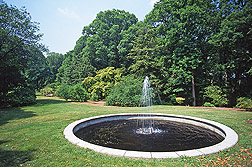Public Gardens and ARS
Working Together in Plant Preservation
|
|
Have you ever wondered what you would do if your favorite landscape plant was threatened to near extinction by a pest or disease? Well, it has happened several times throughout history and continues today. The recent and potentially catastrophic infestation of the emerald ash borer (Agrilus planipennis) has threatened to destroy native ash trees. Currently, sudden oak death (Phytophthora ramorum) is attacking oak trees in the West and threatens to spread to the rest of the country.
Since the beginning of the 20th century, the Agricultural Research Service and public and private cooperators have been working hard to ensure that we are better prepared to conserve these key components of our native forests, parks, gardens, and yards. In 1990, Congress reaffirmed its commitment to ornamental plant conservation by charging ARS with the enormous task of preserving highly valuable woody ornamental plant germplasm. It became apparent to ARS leaders early on that successful plant collection and preservation could not be accomplished without cooperation between the agency and public and private institutions.
One such partnership exists between the U.S. National Arboretum, part of ARS, and the American Public Gardens Association’s (APGA) North American Plant Collections Consortium (NAPCC). The NAPCC is a network of arboretums and botanical gardens focused on collecting, maintaining, and preserving plant germplasm from all over the world. This year marks the 15th anniversary of the partnership between NAPCC and ARS. Built on a mutual interest in conserving plant genetic resources, it works well because both ARS and APGA are committed to setting a high professional standard for managing garden collections for the purpose of plant conservation.
The plant collections of botanical gardens and arboretums in North America represent a significant sample of the entire plant diversity found throughout the world. Including more than 100,000 acres and half a million diverse collections, the nearly 500 institutional members of APGA can be a major force in landscape plant conservation. Pam Allenstein, manager of NAPCC, explains: “Our members follow a high curatorial standard and have a long-term commitment to plant preservation to ensure that germplasm is available for future use.” Coupled with ARS’s National Plant Germplasm System, which manages working collections of more than 530,000 plant accessions, it has become a formidable partnership for success.
The National Arboretum’s Woody Landscape Plant Germplasm Repository, which is curated by horticulturist Kevin Conrad, helps facilitate this critical collaboration between these two organizations.
“Our role is to work closely with NAPCC and Pam to help bridge the gap between the responsibilities of federal government and APGA and combine the resources each can contribute to woody landscape plant conservation,” says Conrad. “We also focus on plants not covered by NAPCC’s program or which might not be a high priority for them.”
Thanks to this continued cooperation, we can rest assured the plants we enjoy and rely on will be here for years to come.—By Stephanie Yao, Agricultural Research Service Information Staff.
This research is part of Plant Genetic Resources, Genomics, and Genetic Improvement, an ARS national program (#301) described at www.nps.ars.usda.gov.
Kevin Conrad is in the USDA-ARS Floral and Nursery Plants Research Unit, U.S. National Arboretum, 10300 Baltimore Ave., Beltsville, MD 20705-2350; (301) 504-5196.
"Public Gardens and ARS Working Together in Plant Preservation" was published in the November/December 2010 issue of Agricultural Research magazine.







